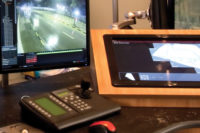Aflac, a Fortune 500 company, with annual revenues of more than $25.4 billion, had used a self-described “workhorse”-style access control system for many years in the company’s locations in Columbus, Ga., Omaha, Neb., and Albany, New York, as well as in its newest locations on Wall Street and in Columbia, S.C. With company-wide growth and the Columbia location alone experiencing near 100-percent employee growth rate the last few years, the system’s time was up.
“We knew it was a huge endeavor to install a new system, but we wanted to ensure that we had one card for all locations so if anyone was traveling from location to location they wouldn’t have to carry two or three badges. They would just carry one badge and have access that way,” shared Scott Shaw, CPP, CBCP, senior manager, Security, Transportation, and Emergency Preparedness, Aflac Worldwide Headquarters, Columbus, Ga.
Aflac looked at several systems, doing its due diligence, and ultimately decided that the access control offering from S2S2 Security, Framingham, Mass., an independent manufacturer of IP-based physical security and video management systems, was the way to go.
The system’s reliability and a 100-percent Web browser-delivered user experience were key selling points.
“S2 provided the best solution for us because it was the most compatible with what we already had, so it would interface better with our old system,” Shaw said. “Plus, our green initiative here at Aflac is quite large and is growing at an accelerating rate. That was also a key reason we chose S2. We basically were at like a first-generation access control system and we wanted to move to a Web-based second- or third-generation system,” he described.
The project’s integrator, Tech Systems Inc., Duluth, Ga., has worked with Aflac for more than 10 years.
“We had a Focus Agreement, which is an enhanced service agreement, for 10-plus years doing service for Aflac on their legacy system. So we knew where all the gremlins were, and we knew all the areas that we needed to concentrate to make sure that we did the right thing whenever we changed out the panels,” describes Stephen Allen, CPP, Client Support, Tech Systems.
When tasked with the full system upgrade, Tech Systems went through a detailed planning process. The team made sure that before converting to the new system that every panel, reader, and card was planned across every building in every Aflac location so that the conversion would be a seamless process.
“There was an incredible amount of planning on the front end to make the transition so smooth that the employees wouldn’t see a change,” Allen said. “We identified all of the areas that could be a stepping stone or a hiccup in the process such as network drops, fire alarm relays, etc.,” he added.
The process of changing out the hardware took two-and-a-half months. Tech Systems approached it systematically, taking one panel, converting it over to the new system, and then, once ensuring everything was up and running, moving to the next panel. After all the panels were successfully changed out, technicians began working on all the readers. With the readers installed, Aflac then distributed new cards for everybody, and the change-over began.
“We started on a Friday afternoon of changing over the readers and work was finished on Sunday morning,” Allen said.
The seamless transition was a major win for corporate security, according to Shaw. “Most employees didn’t even realize that this had taken place, even though we communicated to everybody that this was happening in our portal. It was the old system on a Friday and a new system on Monday,” Shaw said.
PROJECTS in the News
IQinVision, a provider of high-performance HD megapixel IP cameras, announced that the Caddo Parish Public School system, in northwest Louisiana, made a major commitment to utilizing IP video surveillance throughout the entire school district. The major, on-going project is being managed and installed by Stanley Security Solutions.
Prior to upgrading to IP megapixel surveillance, Caddo employed a variety of surveillance technologies and makers that varied from campus to campus. Steve White, director of construction and capital projects for Caddo Schools, noted that that they also suffered from storage issues with the old DVR technology, “We would view something on Friday, and come Monday when we’ve decided we want to see it again, the event had already been over-written,” White said.
The move to unify and upgrade all surveillance technologies started in the summer of 2011 and was given a push by the need to consolidate some of the schools.
Caddo selected IQinVision HD megapixel cameras for the extensive roll-out to all 68 school campuses and the main administration campus in the summer of 2012. “These IQeye cameras were a big step forward for us,” White recalled.
The number of IQeye cameras deployed in the elementary schools is the smallest, running about 100; middle schools require approximately 150-200 cameras; and the high schools often deploy 300 or more cameras. Caddo Parish has installed around 4,000 cameras to date, and upon completion approximately 7,000 total IQeye HD megapixel cameras will be deployed. IQeye Alliance dome and Sentinel models were selected and the camera resolutions range from 1MP up to 5MP, depending upon area of coverage and desired image quality needs. White estimates that 80 percent of the cameras will be installed inside schools buildings and the remaining 20 percent outside.
■ ■ ■
HID Global®, a provider of secure identity solutions, announced that its EdgeReader® ERP40 networked access control solution and iCLASS SE® platform readers were selected by systems integrator Performance Buildings® to create an intelligent facility management system for “on demand” access to shared and temporary offices. Performance Buildings offers the new solution to its customers that include property management companies and landlords in Switzerland and Germany. The solution enables end users to access rented office spaces with legacy technology, existing smart cards and NFC-enabled smartphones.
To address the different needs of their customer base, Performance Buildings was looking for a flexible identity and access management system that could be applied to any type of building and any type of legacy system for use in a range of different application scenarios. In addition, the solution needed to be interoperable with Performance Buildings’ current IP-based architecture that links all subsystems and their devices, as well as meet the needs of Design Offices, one of Performance Buildings’ property management customers that provide office space to end users.
“Identity management touches everything in the Performance Buildings grid.” said Dr. Vishal Mallick, CEO of Performance Buildings, “A strong identity management governance structure was required from Design Offices to facilitate a seamless experience for their existing tenants and clients using the facilities “on-demand“, including the ability to book rooms and catering services online, open conference room doors, and sign out once their session is over. It was important to offer a wide menu of services to enhance the way we do business.”
■ ■ ■
Amidst the usual chaotic humor and historical factoids presented weekly on History Channel’s show,“Pawn Stars,”depicting the actual day-to-day business of the real Las Vegas “World Famous Gold and Silver Pawn Shop,” a recent episode, entitled “King of Pain,” also inadvertently co-starred the Gemini Keypad from Napco Security Technologies Inc.
The great success of the American reality TV show, “Pawn Stars,” one of History Channel’s highest rated, has reportedly been a boon to the real Gold & Silver Pawn Shop location, now a Las Vegas tourist destination. It is said to have gone from serving an average of 70 to 100 customers daily to more than 1000. To accommodate this increased retail traffic, and to add a TV-merchandise gift shop and in-house gym, the Gold and Silver Pawn Shop building reportedly underwent a $400,000 expansion, increasing the showroom by two thirds. The shop’s valuable inventory likewise has grown.
Security is obviously an important factor for this iconic commercial establishment, given the value of the World Famous Gold and Silver Pawn Shop’s considerable inventory, large cash reserves (as show viewers know, they “pay cash in $100 bills”), also its public exposure and 24-hour operation in a way-way-off-strip, urban area. In a press release, Napco stated it was pleased that its Gemini Security System and Custom Alpha Keypad were selected to provide real protection by the shrewd Harrison family owners.
For information, visit www.napcosecurity.com.
■ ■ ■
Genetec, a provider of unified IP security solutions, announced that the company’s AutoVu License Pay-by-Plate System was chosen by the Borough of State College in Pennsylvania to become part of one of the country’s first license pay-by-plate parking (PBP) systems.
The new parking system that will soon be fully operational is a PBP system featuring the Genetec AutoVu License Plate Recognition System combined with technologies from T2, a provider of unified parking management systems, Parkmobile a developer of mobile parking payment solutions, and Digital Payment Technologies, a developer of electronic multi-space pay stations management software.
Having recently installed Genetec AutoVu LPR cameras on their parking enforcement vehicle, the Borough’s parking officers are now able to automatically capture license plate numbers to enforce parking permits, time-limited zone rules, and parking lot checks.
“We have about 2,000 cars that are eligible to be booted at this stage and AutoVu has already proven to be a highly effective tool at finding the people who owe us money, with very little effort. At this rate, we expect the system to pay for itself in 18 months or less,” explained Charles DeBow, parking manager, Borough of State College.
■ ■ ■
Recognized by Money Magazine as one of the country’s best small communities in which to live in 2007, the city of Suwanee, Ga. was recently in the market for an IP video surveillance system. The goal was to maintain and improve the safety of the city as well as provide open Wi-Fi in its parks.
Dan Nestor, C3 Communications integrator on the project, reported that a major challenge was to design a wireless mesh network over several square miles that would support backhaul for multiple communication mediums (data, voice, and video) while reducing or eliminating recurring costs for carrier-provided circuits. He also was faced with expanding and improving upon a wireless network that the city had previously installed, but was experiencing problems with.
Nestor chose a solution from Fluidmesh to meet the demands of the project without having to install underground fiber optic cable. He explained that the system was originally installed as a “hub-and-spoke” with the City Hall Clock Tower as the hub and several spokes supporting the public works building and city parks. “As we designed, and continued to implement additional facilities, we created a true mesh network,” Nestor said. “We installed multiple Fluidmesh 2200 and dozens of FM11100 radios.”








